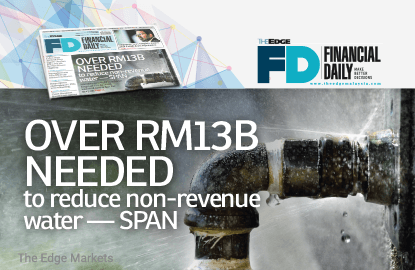
This article first appeared in The Edge Financial Daily, on July 26, 2016.
CYBERJAYA: The regulator of Malaysia’s water industry estimates that more than RM13 billion worth of investment in water distribution systems is needed to achieve its non-revenue water (NRW) target of 25% by 2020.
It, however, remains to be seen when the investment can be put into place. More than 10 years after the federal government put into law that it will be the sole custodian of water assets in an effort to cool down the country’s escalating costs to supply treated water, only seven states have handed over their assets to Putrajaya.
But a tariff increase is still necessary, although many states have not budged. The landscape of the water industry has changed over the last decade, with an increasing population and a lack of new water infrastructure to provide quality water services, which in turn require the government to increase water tariffs to fund capital expenditure (capex) and operational expenditure.
In an interview with The Edge Financial Daily, National Water Services Commission (SPAN) executive director of water regulatory department Marzuki Mohammad said the regulator conducted a study last year, and found that the country needs over RM13 billion worth of works to shave the NRW rate. The investment figure includes replacement and installation of water pipes and meters.
Malaysia’s NRW — the industry’s nomenclature for treated water not billed due to theft or that which never reaches paying consumers — stood at 35.6% in 2014, which was just 1% lower than the previous year, according to SPAN. The range for individual states’ NRW two years ago spanned from 21.4% (Melaka) to 55.8% (Perlis).
“When you talk about managing NRW, you have to manage it holistically. You can’t do it on a piecemeal, just by replacing the whole pipe. You [also] have to install meters to measure how much water is wasted. From that mapping, you can zoom into pipes that need to be replaced,” said Marzuki.
He said there are three components making up NRW, namely “physical”, “commercial” and “unbilled authorised consumption”. The third category takes up only between 1% and 2% of the pie, he added, and is a necessary form of NRW because it is used for purposes like firefighting.
Three quarters of NRW fall into the “physical” category, where losses are those through leakages from pipes. The rest comes from “commercial” NRW, which includes water theft and meters under-reading consumed water.
According to Marzuki, it is impossible to take NRW down to an utter zero. Much of the unbilled water is still consumed, “but you can save on physical losses”.
“[Reducing] NRW is all about investment. Thirty per cent of our pipes are still the ones made of asbestos cement, which are way beyond their useful lives ... [while] old meters that are more than 10 years old tend to under-register [reading],” he explained.
In 2005, Parliament amended the 9th and 10th schedules of the Federal Constitution, which essentially give the federal government the authority over water services and management of revenue from water supplies and services in the states, but leaving operations to the states (Sarawak and Sabah were not included in the water restructuring exercise).
This stemmed from concerns over ballooning costs of private concessionaires supplying treated water, given that their costs of debt would be those of market rates.
After the Water Services Industry Act 2006 was enacted in 2008, the idea was to have the federal government taking over water assets from the states, and park them under Pengurusan Aset Air Bhd. The latter would then assume the financing responsibilities, as its status as a government-owned company allows it to attain more favourable rates.
“Once these states have migrated their assets, there is a specific programme where you need to invest in NRW, and there is a KPI (key performance indicator) imposed on the states,” said SPAN chief executive officer Datuk Mohd Ridhuan Ismail.
The seven states that have handed over their water assets to the federal government are Melaka, Negeri Sembilan, Johor, Perlis, Penang, Perak and Selangor. But there is an asterisk attached to Selangor, as its biggest water treatment operator, Syarikat Pengeluar Air Sungai Selangor Sdn Bhd, a 40%-owned unit of Gamuda Bhd, has yet to reach an agreement over the selling price.
As the government will no longer fund water reticulation systems under the Malaysia Plan, he said putting the country’s water restructuring exercise into policy would pressure state governments to migrate to an asset-light model.
“But it is not taking effect yet [for some states], as probably there are additional funds from the state governments to fund their capex.”
When the RM13 billion worth of investment is approved, public listed companies that could benefit from it include pipe-makers YLI Holdings Bhd, Hiap Teck Venture Bhd, Jaks Resources Bhd and Engtex Group Bhd. George Kent (M) Bhd, meanwhile, produces water meters.